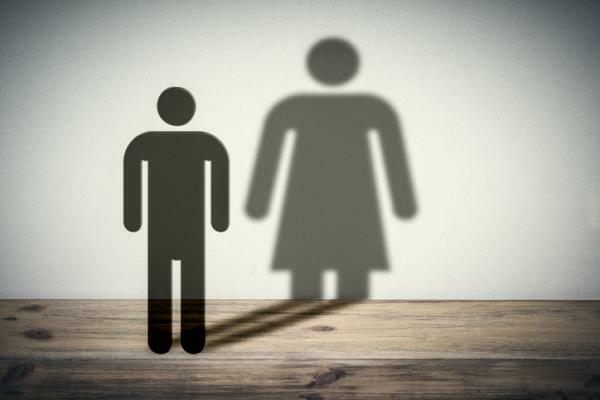
Imagine living in a body with which you do not feel identified. Most people are comfortable with given sex, but what if that doesn't happen? Faced with this feeling of not feeling identified with the biological body and the discomfort that this may entail, we find ourselves with gender dysphoria. From Psychology-Online, we want to offer a little more information for all those people who may be interested in knowing a little more about what is gender dysphoria, its symptoms and causes.
Index
- What is gender dysphoria?
- Gender dysphoria and DSM V
- Symptoms of gender dysphoria
- Difference between gender and transgender dysphoria
- Causes of gender dysphoria
- Treatment of gender dysphoria
What is gender dysphoria?
Gender dysphoria is understood as the no congruence between the sex of the person and what the person feels or expresses. I mean, I can be a man because my genitals indicate so, but I feel like a woman. This supposes a discomfort for the person. It should be noted that gender dysphoria is independent of the pattern of sexual arousal, not because you are a man and feel like a woman has to be attracted to men.
Gender dysphoria and DSM V.
Is gender dysphoria a disorder? Gender dysphoria is a new category in DSM-V. Previously, in the DSM-IV-TR it was in the category of sexual disorders and sexual identity. This has been modified, since the accent has been on gender congruence. Different criteria are included, as we will see later, depending on age.
This sex-gender incongruity affects on average 1 in 30,000 men and 1 in 100,000 women. The main characteristics of gender dysphoria are:
- The feeling of discomfort with one's genitalia and the desire to free oneself from one's own sex and live as a member of the other sex.
- Strong desire to belong to the other sex and to eliminate primary (genital organs) and secondary sexual characteristics: breasts, widening of the hips in women, menstruation, pubic hair. In men, a deeper tone of voice and an increase in the size of the genital organs.
- Desire to live and be treated as a person of the other sex.
- The desire its permanent at the time, must be present a minimum of 6 months.
- The desire generates discomfort important in the person.
Symptoms of gender dysphoria.
Apart from the characteristics mentioned above, gender dysphoria can present different symptoms depending on age.
In children there is a marked incongruity between the sex that one feels and expresseswith which he / she is assigned associated with a powerful desire to belong to the other sex that manifests itself, in the case of children (assigned sex) by a strong preference for cross-dressing or gender-related actions feminine.
In the case of girls (assigned sex), a preference is observed to wear only clothes considered as a child and a clear resistance or opposition to wearing clothes considered feminine (skirts, dresses, etc.). In addition, they also express the desire to want to be part of the other sex and insist on performing the role that society considers of the other sex.
To consider it gender dysphoria, that not belonging to the sex that one wants with the one they have must be associated with significant discomfort, social and school deterioration or in other important areas in the child's life.
In summary, the main symptoms that we find in gender dysphoria are the following:
In the kids
- Feeling that the penis is horrible.
- Rejection of games more typical of the male gender.
In girls
- Feeling that it would be better to have a penis.
- Preference for toys considered masculine.
- Refusal to urinate sitting down.
Parents tend to consult more about feminine behaviors in their sons than about masculine behaviors in their daughters.
In adolescents and adults, in addition to being able to find all the previous characteristics, we also find rejection and anguish before the appearance of secondary characters.
Difference between gender and transgender dysphoria.
Transgender people do not identify with their biological sex. They want to live and be accepted as members of the opposite sex. For example: a transgender woman is a man on a morphological level, since she has the primary characters of a man, but she recognizes herself as a woman. We speak of gender dysphoria when, in addition to not identifying you with biological sex, it appears accompanied: anxiety, discomfort, and strong rejection made the body itself. Therefore, the difference between gender and transgender dysphoria is that in the former there are anxious symptoms and psychological distress.
Causes of gender dysphoria.
To this day, the causes of gender dysphoria are not known. It is believed that different factors may intervene: genes, hormones, and culture and environment.
At the biological level, the brains of men and women have small differences, in many cases due to the different hormones that we secrete. In studies done with rodents, to study sexual dimorphism and establish a hypothesis about the causes, it was seen that the bed nucleus of the terminal stria was greater or less based on testosterone levels. That means that the nucleus in men will be larger than in women. From here, it was extracted that people with gender dysphoria have this nucleus that is more similar to the opposite sex.
Even so, it should be noted that to this day the exact causes are still unknown and that all the information are hypotheses.
Treatment of gender dysphoria.
Due to the different social and family pressures, it is common to find effects on the mental health of the person with gender dysphoria. For this, psychological support is important in all stages and possible treatments that we will see below.
How to help someone with gender dysphoria? To treat gender dysphoria, it is essential to have a team of specialists multidisciplinary (endocrinologists, psychologists, psychiatrists, etc.). The goal of treatment is to help the person with gender dysphoria overcome the distress they feel. On many occasions, this includes helping the person make the transition to the gender with which they identify.
Lines of intervention
What lines of intervention can we find in the face of gender dysphoria?
- Psychological and medical support to help the person understand their feelings, provide support, and seek coping strategies. here you can see more information about gender identity, what it is and how it is constructed.
- Hormonal therapy, with sexual lasts.
- Surgerysex change. In the case of the operation, the person must have undergone hormonal treatments and have lived according to the gender with which they identify for at least one year before performing the surgery.
- Family and partner support to help reduce conflicts and provide a supportive climate in the situation.
Here you can read some reflections on gender.
This article is merely informative, in Psychology-Online we do not have the power to make a diagnosis or recommend a treatment. We invite you to go to a psychologist to treat your particular case.
If you want to read more articles similar to Gender dysphoria: what is it, symptoms and causes, we recommend that you enter our category of Clinical psychology.
Bibliography
- American Psychiatric Association. Gender dysphoria. In: American Psychiatric Association. Diagnostic and Statistical Manual of Mental Disorders. 5th ed. Arlington, VA: American Psychiatric Publishing. 2013:451-460.
- Belloch, A., Sandín, B., Ramos, F. (2008). Mannual psychopathology. Madrid: McGrawHill.


